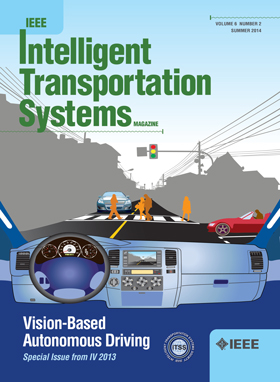A Human-Like Trajectory Planning Method on a Curve Based on the Driver Preview Mechanism
IF 7.9
1区 工程技术
Q1 ENGINEERING, CIVIL
IEEE Transactions on Intelligent Transportation Systems
Pub Date : 2023-06-22
DOI:10.1109/TITS.2023.3285430
引用次数: 0
Abstract
With the development of intelligent vehicle technology, many studies have been focused on developing human-like trajectory planning methods for automated driving systems. Although data-driven methods are widely used for human driver behavior learning, there have been fewer studies on realizing human-like trajectory planning by using the generation mechanism of driving behavior, especially under curve conditions, where the lane centerline has been denoted as a reference trajectory. In this paper, thirty-two skilled drivers were recruited to collect data under different curve conditions on a self-designed driver-in-the-loop system. The collected data are processed by dynamic time warping, trajectories with different lengths are warped and the abnormal data are removed. Based on the warped data, common characteristics and differences between left and right turning trajectories are compared and explored from the perspectives of drivers’ demand for turning performance and their visual attention mechanism. Then, by introducing the driver preview mechanism, two features with a strong ability to represent the generation mechanism of the driver’s curve driving behavior are introduced. Finally, the preview-based human-like trajectory planning model (PHTPM) is proposed, and it is verified and analyzed by comparative tests and generalizability tests. The results show that the introduction of the driver preview mechanism enables PHTPM to match the characteristics of skilled drivers accurately on left turnings and outperform them on right turnings.基于驾驶员预瞄机制的曲线类人轨迹规划方法
随着智能汽车技术的发展,许多研究都集中在开发用于自动驾驶系统的类人轨迹规划方法上。尽管数据驱动方法被广泛用于人类驾驶员行为学习,但通过使用驾驶行为的生成机制来实现类人轨迹规划的研究较少,尤其是在弯道条件下,车道中心线被表示为参考轨迹。本文招募了32名技术熟练的驾驶员,在自行设计的闭环驾驶员系统上收集不同弯道条件下的数据。对采集到的数据进行动态时间扭曲处理,对不同长度的轨迹进行扭曲,去除异常数据。基于扭曲的数据,从驾驶员对转弯性能的需求和视觉注意力机制的角度,对左右转弯轨迹的共同特征和差异进行了比较和探索。然后,通过引入驾驶员预览机制,介绍了两个具有较强表示驾驶员曲线驾驶行为生成机制能力的特征。最后,提出了基于预览的类人轨迹规划模型(PHTPM),并通过比较测试和可推广性测试对其进行了验证和分析。结果表明,驾驶员预览机制的引入使PHTPM能够在左转时准确匹配熟练驾驶员的特征,并在右转时优于熟练驾驶员。
本文章由计算机程序翻译,如有差异,请以英文原文为准。
求助全文
约1分钟内获得全文
求助全文
来源期刊

IEEE Transactions on Intelligent Transportation Systems
工程技术-工程:电子与电气
CiteScore
14.80
自引率
12.90%
发文量
1872
审稿时长
7.5 months
期刊介绍:
The theoretical, experimental and operational aspects of electrical and electronics engineering and information technologies as applied to Intelligent Transportation Systems (ITS). Intelligent Transportation Systems are defined as those systems utilizing synergistic technologies and systems engineering concepts to develop and improve transportation systems of all kinds. The scope of this interdisciplinary activity includes the promotion, consolidation and coordination of ITS technical activities among IEEE entities, and providing a focus for cooperative activities, both internally and externally.
 求助内容:
求助内容: 应助结果提醒方式:
应助结果提醒方式:


